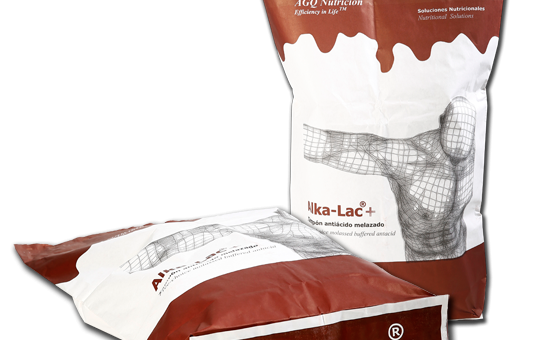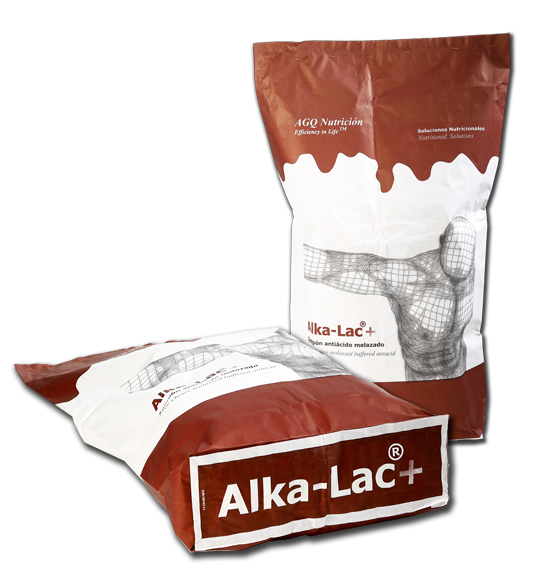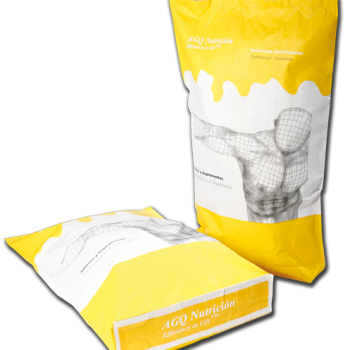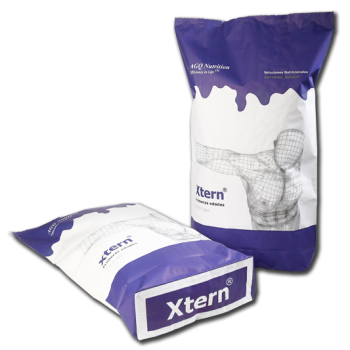
Alka-lac+
Alka-lac+
Acidosis & SARA control for ruminants
Subclinical Rumen Acidosis (SARA) can significantly impact the health and productivity of dairy cows. This condition can lead to milk-fat depression, reduced milk production, and decreased lifespan and lifetime productivity, causing pain points for buyers.
Fortunately, Alka-Lac+ is here to help. Alka-Lac+ is a free-choice blend of potent antacids coated with highly palatable molasses, designed to promote a healthy rumen environment and reduce the risk of SARA. With Alka-Lac, you can provide your cows with the support they need to maintain optimal rumen health and overall productivity, ensuring your investment in your herd is protected. Don’t let SARA compromise the health and productivity of your dairy cows; try Alka-Lac today!
Specifications

ACIDOSIS & SARA EXPLAINED
Sub-acute ruminal acidosis is a well-recognized and economically important digestive disorder in well-managed dairy cattle. It results from feeding high-grain diets to dairy cows and is characterized by daily episodes of low ruminal pH. This condition generally occurs when the ruminal pH stays between 5.2 and 6 for a prolonged period, resulting in depressed fibre digestion, rumen defaunation, reduced milk production and reduced feed efficiency. Remarkably, there are typically no clinical signs of illness in SARA-affected cows.
SARA primarily arises from the feeding practices in dairy cattle management. It occurs when cows are fed high-grain diets as part of an intensive feeding regimen or a high amount of low-fibre, high-moisture forage in free-range conditions. The excess grain consumption disrupts the balance of the rumen’s microbial ecosystem, leading to an accumulation of lactic acid and a decrease in ruminal pH. This acidic environment hinders fibre digestion and can negatively affect milk production, inverse the protein to milk fat ratio in the tank and erode the herd health. Factors such as diet composition, feeding frequency, and cow stress levels can influence the likelihood of SARA occurrence.
The consequences of SARA are multifaceted. While it may not exhibit typical clinical signs of illness, the chronic nature of SARA can lead to several detrimental effects. Reduced fibre digestion means that cows are less efficient in extracting nutrients from their diet, potentially leading to lower milk yields and increased feed costs. Furthermore, SARA can negatively impact cattle health over time, increasing the risk of secondary health issues. Therefore, managing and preventing SARA is crucial for maintaining both the economic viability and the overall well-being of dairy cattle herds.
Key Take Away Points
Overview
- SARA is a digestive disorder primarily found in dairy cattle.
- It results from high grain diets and prolonged low ruminal pH.
- SARA can lead to reduced milk production and is economically significant even in well-managed dairy operations.
Triggers
- High-grain diets and imbalanced rumen ecosystems are primary causes of SARA.
- Factors like diet composition, feeding frequency, and stress levels influence SARA risk.
- Dairy cows, due to their specific dietary requirements, are more susceptible to SARA.
Impacts
- SARA reduces fiber digestion, leading to inefficient nutrient extraction.
- It results in lower milk yields and increased feed costs.
- The chronic nature of SARA can negatively affect cattle health over time, increasing the risk of secondary health issues.
BENEFITS OF ALKA-LAC+
Enhanced Dairy Production
Alka-lac+ optimizes ruminal pH levels, boosting milk production by improving fiber digestion and feed efficiency. This results in increased milk yields and enhanced profitability for dairy farmers.
- Alka-lac+ improves ruminal pH, boosting milk production.
- It enhances milk quality with better butter fat levels.
- Reduces protein-to-fat inversion for increased yields and profitability.
Healthier Cattle and Increased Longevity
Alka-lac+ prioritizes cattle well-being by mitigating SARA, reducing the risk of health issues, and promoting longer productive lifespans. This enhances the overall sustainability of dairy herds.
- Alka-lac+ mitigates SARA, ensuring healthier, longer-lasting cattle.
- Reduces health risks, minimizing the need for veterinary interventions.
- Promotes cattle's overall well-being, contributing to herd longevity.
Sustainability and Economic Viability
Alka-lac+ supports sustainable dairy farming practices, minimizing the environmental impact and ensuring the long-term economic viability of dairy operations. It aligns profitability with sustainability for modern dairy farming.
- Supports sustainable farming, reducing environmental impact.
- Ensures the long-term economic viability of dairy operations.
- Aligns profitability with sustainable practices.
Key Scientific Excerpts
"In Greek dairy herds, the prevalence of SARA was found to be 16% in cows with rumen pH ≤5.5. Factors like feeding regime, particle length size, ration composition, and housing type significantly influenced the presence of SARA"
SARA prevalence in Greece,
Kitkas, Valergakis, Karatzias & Panousis, 2013"Subacute ruminal acidosis (SARA) in dairy cattle is linked with reduced efficiency of milk production, impaired cow health, and high rates of involuntary culling. It may be associated with liver and lung abscesses, laminitis, and reduced ruminal efficiency"
Subacute ruminal acidosis health effects,
Hussain, Amjad-ul-Islam & Gupta, 2011"The prevalence of subacute ruminal acidosis in European dairy herds is around 20%, generating annual losses in the United States of approximately USD 500 million to 1 billion"
SARA Prevalence Europe,
Kovács et al., 2020"Subacute ruminal acidosis (SARA) prevalence in grazing Irish dairy cattle fed predominantly perennial rye grass-based pasture was found to be 11%, with 42% marginal and 47% normal. This raises concerns regarding effective pasture utilization and potential consequences for animal health"
SARA Prevalence,
O’Grady, Doherty & Mulligan, 2008"Subacute ruminal acidosis (SARA) is a common condition in well-managed dairy cattle herds due to high grain and low fibre diets, leading to ruminal fermentation disorders and negatively impacting production performance and farm economy."
Economic Impact of SARA,
Mathew & Ajithkumar, 2014"Sub-acute ruminal acidosis (SARA) is a significant metabolic disease affecting high-producing dairy cows. SARA leads to reduced milk fat and protein production, increased veterinary costs, and a higher risk of culling."


